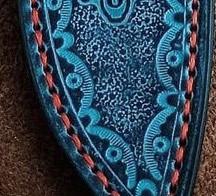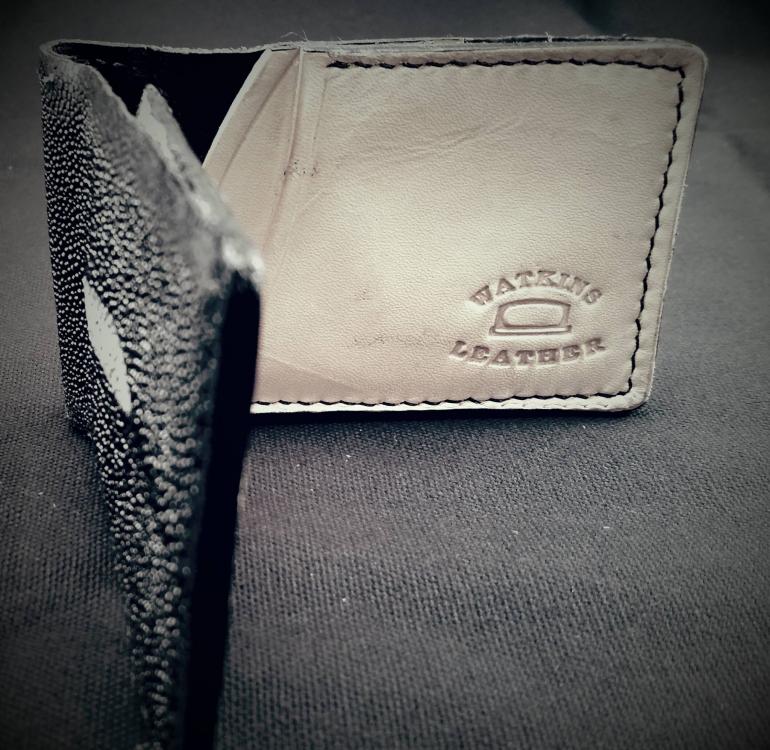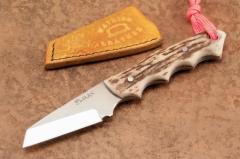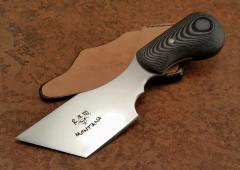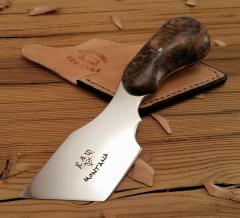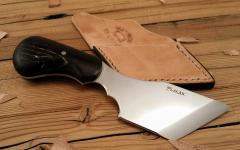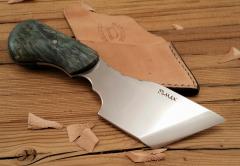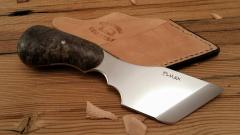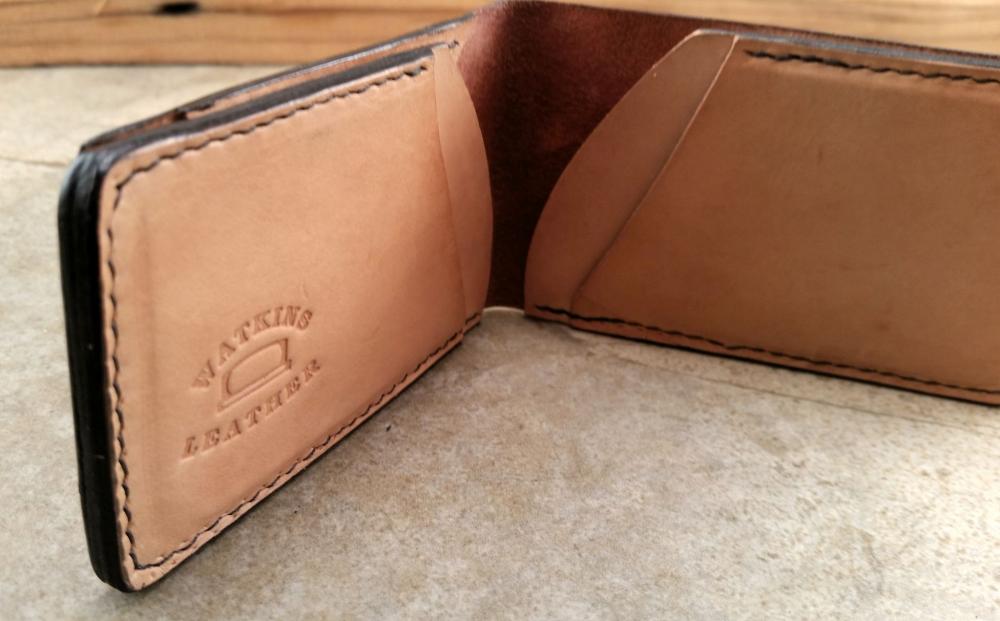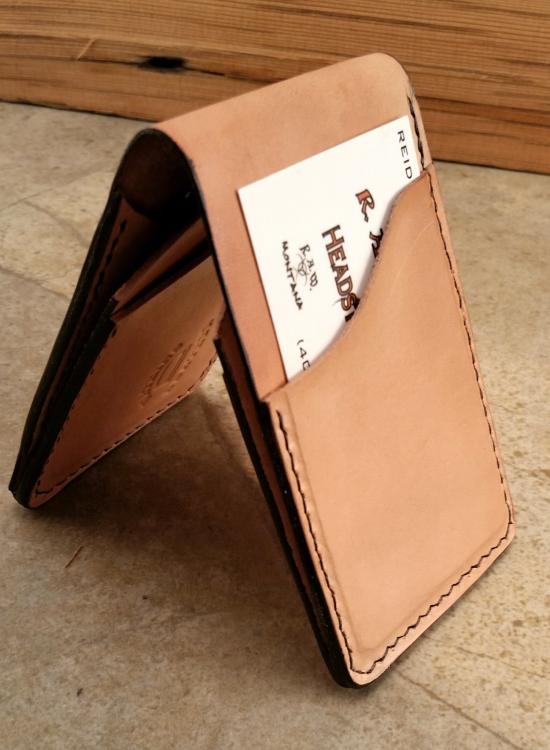-
Posts
328 -
Joined
-
Last visited
Content Type
Profiles
Forums
Events
Blogs
Gallery
Everything posted by rawcustom
-
I've noticed this colorful type of antique paste but not sure what it is? Anyone have ideas on what to use? I mix my antique with tankote so I suppose any shoe polish would work, but maybe this is a colorful product.
-
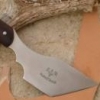
Elmax Elk Antler Trim Knife
rawcustom commented on rawcustom's gallery image in Gallery- Our Leatherwork
-
From the album: Custom Leatherworking Knives and Tools
-
From the album: Custom Leatherworking Knives and Tools
-
From the album: Custom Leatherworking Knives and Tools
-
From the album: Custom Leatherworking Knives and Tools
-
From the album: Custom Leatherworking Knives and Tools
-
From the album: Custom Leatherworking Knives and Tools
-
From the album: Custom Leatherworking Knives and Tools
-
There are several knifemakers on this forum, myself included that can make you a headknife. However, it sounds like you are just wanting the steel and plan to do the rest yourself. That is likely to limit your options. This is a common request from those looking to save money, or those who have something special for a handle in their possession. If it is the latter, many knifemakers will work with you and allow you to supply handle material if it is appropriate to use on a build. If it is the former, than you may have to look a little harder or reconsider your price point. A knifemaker is a craftsman, and I don't know of many good craftsman that are content producing/selling unfinished goods.
-

Hunting Knife with Sheath
rawcustom replied to rawcustom's topic in Gun Holsters, Rifle Slings and Knife Sheathes
Thanks. I too lack faith in the double cap rivet after having multiple fails many years ago. Granted I attribute part of those reasons for not using proper rivet setters, but it shook my faith in them. I have pretty much switched entirely to tubular rivets, but the copper burr rivet has it's place for looks and for adding a wider clamp into the leather. I used it on this sheath for both reasons, looks good, and provides a friction lock against the finger guard when sheathed. -
I'm too busy at work for a full response, but several points here are straying into opinion and are demonstrably false. The theory of "better back then steels", the theory that there aren't steels made for cutting/knife industries today, and lastly the notion of forged steel producing a better end steel product. If you can blame a decrease on steel quality found in common tools today it's a matter of economics more than steel having some forgotten lost art from how it was produced a 100 years ago. The leather industry is a dead industry. That is why there is little selection of quality and most tools available are cheaply made overseas and people are surprised that they don't handle, cut, or wear like the tools of old. Remember steel is only part of your product. Heat treat, grind geometry and ergonomics will all play into your desirability of a knife. If a rifle shoots a ragged hole at 200 yds but weighs 20lbs, it won't be your go to mountain rifle.
-
Well you seemed to arrive at the same point I laid out in the opening post, however your assumption that the alloy is of no importance would be just as wrong as saying the heat treatment is of no importance.
-
Well after much consideration I’ve decided to reply. But first to redress some of the initial comments and clarify a couple of points. Knife Grade steel, as pointed out by Art is not a universally defined term, so has no general accepted criteria or meaning. This is a term I use (my opinion) to define a steel suitable for knife making, typically being content of ~0.7% carbon or more along with usually 2 or more alloy components. There are exceptions, cobalt steel being one of them, but jumping to flint knapped obsidian is beyond a stretch, after all the term uses steel not glass, but thanks for playing. Alloyed steel versus simple steel. A simple steel is carbon + iron, although that’s nearly impossible to find as even the most basic steels incorporate a few extra alloys for added benefits. Alloyed steel or what I refer to as high-alloyed steel is yet another subjective term that I use. To me I define a high-alloyed knife steel as ~0.7% carbon or greater along with ~4 or more alloy elements, or any high percent 1-3 alloys, and I would define this roughly around 5%+. Maybe that is a bit confusing but a couple takeaways. I use and define these terms to talk about steel in knifemaking since the common terms, stainless vs. high-carbon, are meaningless (see first post). Second, an alloyed steel or what I would refer to as a high-alloyed steel does not mean stainless. It can be stainless, but there are many, many that are not. Now the real sticking part with folks is that I can say that the performance aspect of a knife (or really steel in general) can be improved with alloys. What I didn’t say is that these changes are preferred or desired as that is a matter of personal preference. You can argue that a pocket knife should be stainless, or that chisels of SV-35 would be too hard to sharpen (personal opinions on use, not relevant to the discussion), but what you can’t argue is that a simple steel such as 1080 can hold an edge as long SV-35, or that 1080 can take the toughness abuse of 5160 or 52100 or that 1095 will retain a red temper as well as M2. But remember, just because you can increase a steels attributes in what I consider the aspects important to a knife (edge retention, toughness, durability) does not make the knife “better” for a given user or task, again personal preference. Increasing any one of the attributes often comes as a trade-off, such as better edge retention will be harder to sharpen. Just as importantly the steel alone will not dictate the user’s satisfaction of the knife. Steel and heat treatment (hardness), grind geometry, and fit and functionality for the desired task, are all vital to overall satisfaction of use. So just because a steel can be produced to have an increase in a given attribute does not mean an increase in desirability by the user since preferences vary widely and wildly and they always do. Again I will state this thread has nothing to do with “what steel is best” because that is really nothing more than “what steel do I like best”. If you read my original post I am attempting to give the average consumer some information about steel used in knifemaking that goes beyond the simplistic, inaccurate notion of a 2 categorical system of “stainless” vs “high-carbon”. It also has nothing to do with the benefits of a custom knife being “custom”, or being able to have someone make your drawing into a knife (personal opinions about custom knives, not relevant to the discussion). Lastly it involves marketing only in the sense that hopefully those of you that read this will have a better idea to see through the BS, and look for what matters to you. Now if you want to argue for your favorite steel, by all means start a thread and get to it. That is a pointless debate and not one I will engage in. I do regret playing along to start with, but that simply isn’t what this thread is about. If you want to add some helpful information (maybe someone else can try to explain “surgical stainless”) or would like to clarify some common misleading information to help demystify choosing steels or good resources on the matter, than please join in. So what was this post all about? This is a forum for leatherworkers, many of which are getting started or looking to improve their game. There is a wealth of knowledge being shared on every type of leather, treatment of leather and working of leather including the knives to cut leather. For those who are looking to buy or build a knife for cutting leather, there simply isn’t much information out there aside from a few known brand names or makers. Lots of assumptions and lots of the “high-carbon” cries. As I’ve tried to point out, there is much more to a steel than what most assume. Those who read this in their search will hopefully use this information to end up making a better choice as to what would be more suitable for their needs, or at least learn enough to talk to a maker, or determine what steel they have before trying to make it into a knife. You should consider what attributes are important to you, or what you are trying to accomplish and start there. Maybe to some having a knife that you can hammer through a 2x4 makes a lot of sense. Personally I would rather use an axe or a saw, but if that’s your bag you should be looking into spring steels and differential tempered steels, all things that will require you look deeper than “high-carbon”, or even more meaningless “carbon”. So don’t buy a knife because it’s “high-carbon” or because it’s “stainless” (unless you buy cars because they are “wheeled” or “motorized”). You put time into finding the right leather, the right dye, the right conditioner, so don’t expect steel to be any different.
-
Ha! That's number 2 on my list and seeing how thus one is going I doubt I'll kick that hornet nest!
-
If anyone would like to quote me where I stated stainless is better than or where high carbon is better than, please do so. Otherwise I ask people don't try to argue that as I know like Art that argument has no end. Also steel is iron+carbon. Alloy steel is iron+carbon+other elements
-
Back to arguing for stainless vs nonstainless. I suppose I could keep up this pointless back and forth. Art you are following, please delete this thread. I feel Martyn has won the disinformation campaign and this will only serve to confuse people more than help. The High-carbon vs Stainless idiocracy continues!
-
Martyn, you really need to stop posting as you clearly are trying to draw a stainless be nonstainless comparison that I have stated in near every reply is not the purpose of this thread. You argue against alloy steel by citing an alloy steel so I see no validity in continuing a discussion trying to educate you beyond stainless and nonstainless. At thus point your simply diluting the thread with nonsensical replies. If you really wish to continue than I suggest we PM. Otherwise you only help confuse those wanting to learn something. I'm sorry I can be more patient but you continue to argue against the same side you are cheering. And the video is cute but pointless. All it proves is you can break a knife with a hammer and spoiler alert, you can break all knives with a hammer.
-
Just a recap, before too many feathers get ruffled. I haven't stated a single steel is the best for all purposes because that's opinion. I have stated the difference between some common marketing words out there, and will state again that yes, an alloy steel will out perform a simple steel except price, and I guess I should add work ability. I'm not saying stainless is best, or high-carbon is best. I am saying that a properly alloyed steel is better than not. If you want edge retention look for vanadium, if you want shock resistance look for lower chromium and molybdenum, if you want corrosion resistance than chromium or nitrogen steel. Some alloyed steels don't need much alloy, 0.5% vanadium makes a difference, but they are still better knife blades than those without.
-
I'm not sure why you keep jumping back to chromium content. If you read my statement I say that an alloyed steel is better in knife making than a simple (carbon and iron only) steel. I work with 1080 and I like it for certain applications. Again, not everything needs to be stainless or high-alloy, but it is far from being a tough steel. If were going to talk tough steel I would start with CPM-3V. If you just want to talk toughness in general I would go with S7. Also 1080 used in knifemakig is not a true simple steel. It contains manganese, sulfur, phosphorous, and sometimes vanadium.
-
Long held beliefs. You are arguing for "carbon" steel being better at impact and stress than an alloyed steel. Please list which "carbon" steel this is. I would also like to know which "carbon" critical structure steel is you are referring to that has higher strength and toughness?

.jpg.d60258221c476480a6e073a8805645bb.jpg)
